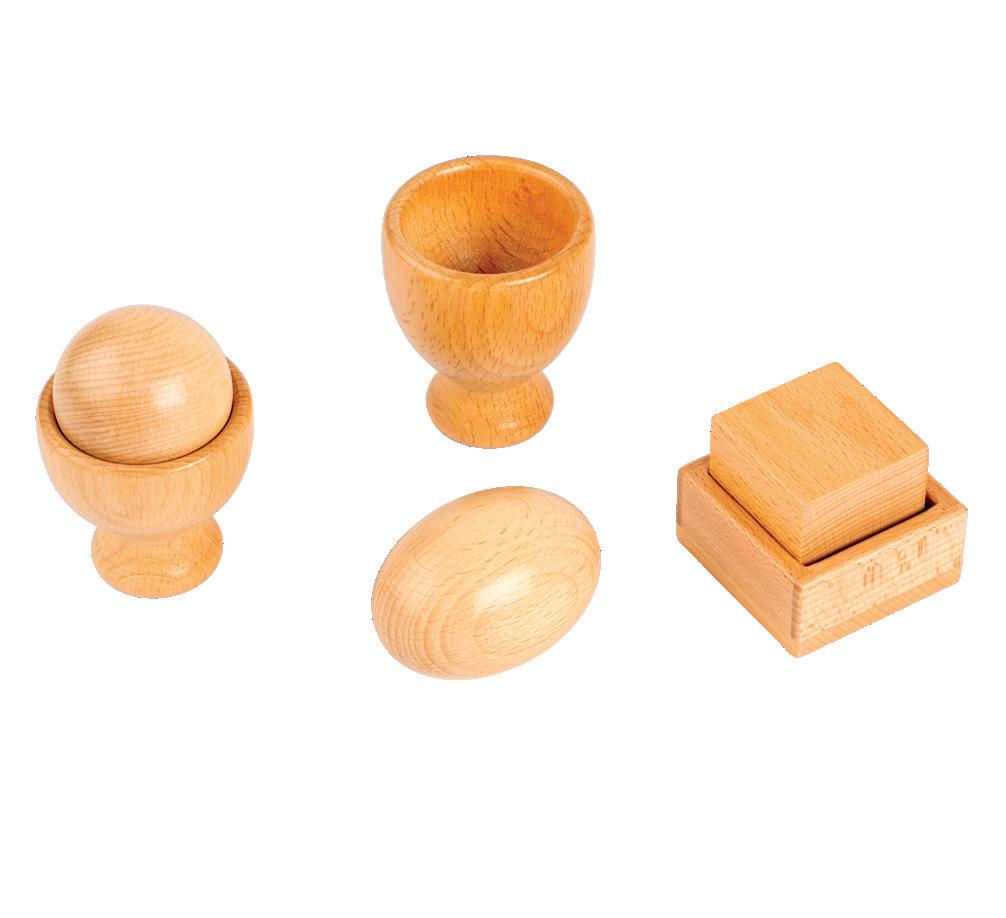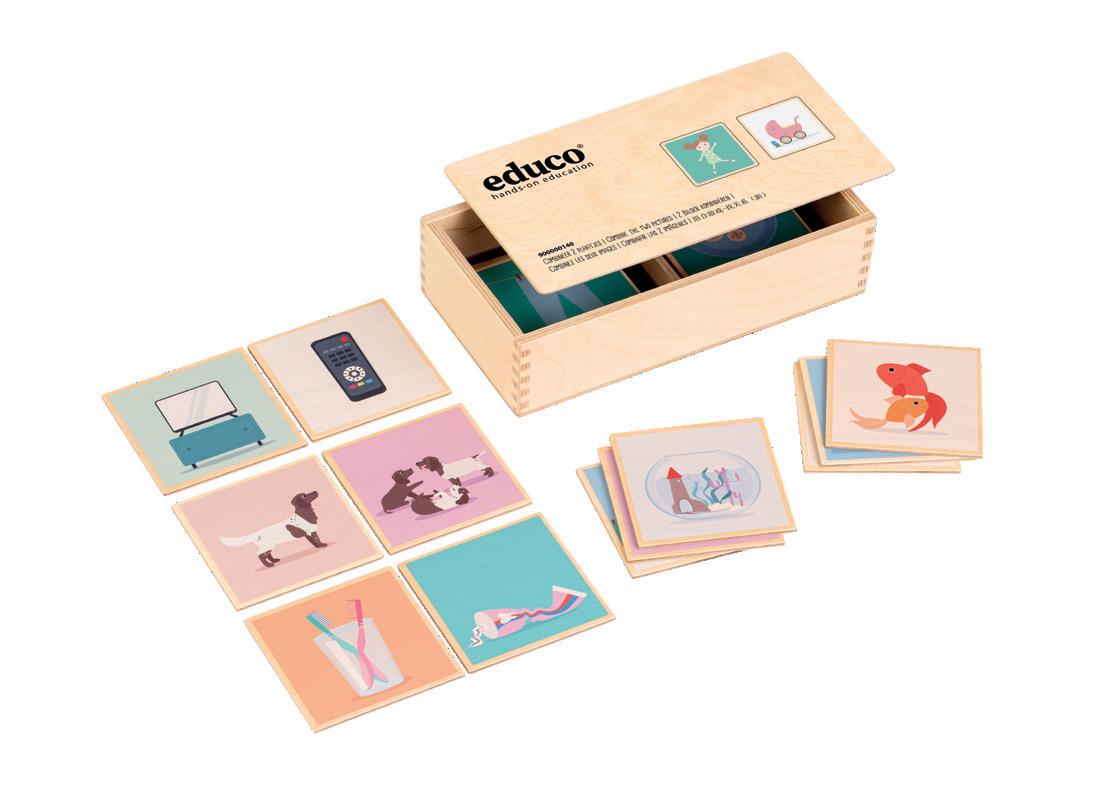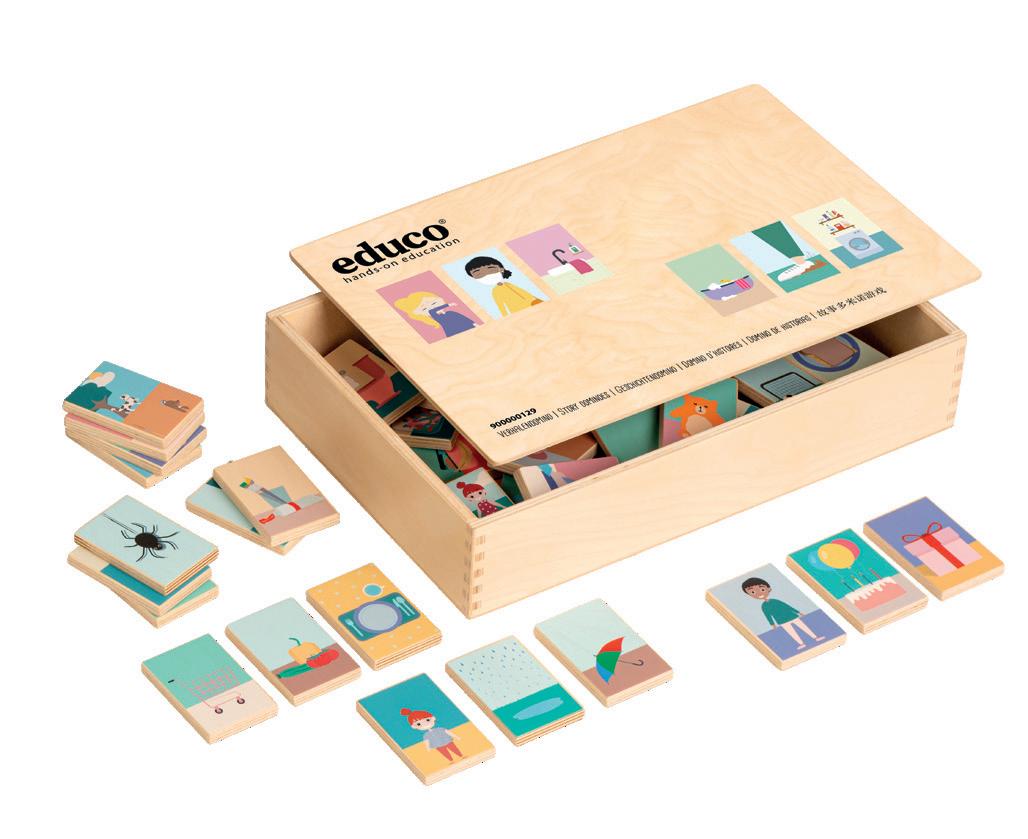new
- New Educo style
- New age group from 0 to 12


- Sustainable approach

2023
Since 1985
Privacy & Security
Tout About Toys Respects Your Privacy!
• Tout About Toys recognizes your right to confidentiality and is committed to protecting your privacy.



• We protect your personal information against any unauthorized access or release. Tout About Toys will not give, sell, rent, or loan any personal information to any third party.
• When you order, we will ask for your name, e-mail address and mailing address, as well as certain other pertinent information regarding your order.
Safe Shopping Guarantee
ToutAboutToys.com is a “Secure Site” recognized by VeriSign, a leading computer network security company. If you believe that someone has improperly used personally identifiable information about you or has made purchases that you did not authorize, please contact us immediately at 800-589-1523. Additionally, all transactions are encrypted for your protection and your credit card information is never saved on our servers.
We maintain reasonable physical, technical, and procedural measures to limit access to personal information to authorized individuals for appropriate purposes.
About Us

Tout About Toys started with a single product - a hand-crafted play rug. That one play rug has evolved into a full-line school supply business with materials to supplement all curriculum areas! Starting in the San Francisco Bay Area, we grew to service California, then the United States, and now the world.
Heutink USA, Inc. is a premier educational supply company distributing products under two customer-facing brands – Nienhuis Montessori and Tout About Toys. Heutink USA, Inc. is based in Gilroy, CA and is part of the Heutink Group, an international company with a presence in multiple countries. The Heutink Group designs, develops, manufacturers, and distributes educational products with over a 100-year history in education.
Contact Us
Please contact us If you have any questions or need additional information:
Gilroy, CA 95020 service@toutabouttoys.com 800-598-1523 600 E. Luchessa Ave. Mathematics Number sense
Our children
We love to look at the world through the eyes of a child. Pure, playful and open-minded. How wonderful is it if they can combine hand-on experiences and learning? In a playful way, we want to introduce them to important themes that they will deal with later on. And stimulate their creativity as well.
We consider this as our obligation to our children
Our planet
With a bit of imagination, you can see our planet as a big schoolyard. The place where you live, learn, play, make friends, sometimes fall down, but always get up on your feet again. We want to teach children that it is our planet that matters most, and how you can contribute to keeping it healthy and tidy.
That makes learning a lot more enjoyable!
Our society
Large or small, thick or thin, young or old and dark-or light-skinned: we do not see these characteristics as opposites. Rather, we see them as complementary qualities that make the planet more beautiful when they blend in and coexist. That is our starting point and it is also reflected in our materials: giving each other space and being kind to each other. Everyone is part of our society and has the right to play along in their own way.
Our products

We do not want to be pedantic, because one teacher at a time is more than enough for a child. Yet our products have a deeper layer. Just look close enough! We hope that our products, which are of course made from sustainable materials, inspire to think and ask questions. About the planet, about inclusiveness, about ecology, about our future and about climate change. Big themes to think about early on.
We provide the tools and toys to get involved early, in a fun and natural way!
‘When everyone is included, everyone wins’, political activist Jesse Jackson once said. We could not have put it better ourselves!
1
Easy to grasp
4-7 months
0-3 years

Move the dolio 900000194
The shapes of ‘Move the dolio’ are easy for a child to grasp. It stimulates grasping and gripping. The moving parts encourage the child to shake the Dolio, giving the child greater control of their hands and arms. Hand-to-hand transfers are encouraged. The body axis is traversed.


The child discovers its own hands and can grasp and move in a more targeted way.
The mouth is the most sensitive part of a child’s body, which is why they tend to put everything in their mouth. ‘Move the Dolio’ was designed with this in mind.

0-3 years 2
First blocks
900000196
Rattle the cylinder
900000195
4-7 months
This rattle is colorful and makes noise, stimulating the senses. With ‘Rattle the cylinder’, a child develops controlled movement and gains greater control over their hands. The rattle encourages movement and exercises the muscles in the child’s torso that are needed for crawling.



These blocks are of an appropriate size for a baby. This builds the child’s mathematical and spatial skills. The blocks will be used throughout the coming years. Helps children gain control and mastery over their hands and helps build the muscles in their trunk.

Spin it!
4-7 months
Rattle and Rings
900000193
‘Rattles and Rings’ stimulates grasp reflexes and hand-eye coordination. Tactile, auditory and visual skills are practiced.
4-7 months
3
Object
900000199

Objects exist even if we do not see them. A new phenomenon for the young child. We call this the peek-a-boo effect, and children enjoy this and learn a great deal from it.
7-11 months
Peek-a-boo
4-7 months
Roll the drum
900000198
When a child is around 4-7 months, they practice with ‘Roll the drum’ in a targeted and developmentally appropriate way. It rolls away from the child a little and then stays there. The child is challenged to go after it. At that age, this demands quite a lot from the child and helps them to develop perseverance.




Spin the drum
900000197
7-11 months
When a child is about 7 to 11 months old, they are fascinated by cause and effect. And they will probably enjoy some more intense games. This all comes together in ‘Spin the drum’. Children rotate the drum themselves. It even produces sound! While doing so, children develop hand–eye coordination and visual skills. Muscles in the wrist and arm become stronger by playing.
permanence box 1
0-3 years 4
Puzzle the Shape
900000203

Fit the shape
900000200
7-11 months
When children are around 7–11 months, they enjoy taking things apart and putting them back together again. This develops the child’s coordination. The child can hold two things at the same time. ‘Fit the shape’ trains the coordination of both sides of the body as your child fits the shapes together.

Ball Tracker
900000290
11-14 months
Place the ball at the top in the tracker and follow it with the eyes. This is an important skill for later learning to read. In addition, it stimulates the concept of cause-effect and object permanence, because the ball briefly disappears at the end of the track.
11-17 months
Practice fine motor skills, spatial reasoning and distinguishing shape and color with ‘Puzzle the Shape’. Vary in difficulty by starting to create one single puzzle and expand to multiple puzzles next to each other.



Slide the Ring
900000205
14-17 months
Slide the rings and practice movements coming from the elbow and wrists. This also strengthens the fist, something that is important for writing later on.
Fine motor skills
7-11 months
Basket with balls
1MM2498
Young children are still discovering the world around them. How do things look and feel? In order to stimulate this ability and their curiosity, the basket contains balls with different textures and colors.

5
Stack the ring
900000202
‘Stack the ring’ requires the child to pick up the rings with precision and place them on the peg. This exercises the fine motor skills and eye-hand coordination. It exercises the understanding of cause and effect and lets the child experiment with it. It stimulates memory and problem-solving



11-14 months
Place the Pin
900000204
11-14 months
String the bead
900000209
Place the pins in the holder and practice movements coming from the wrist. This also strengthens the fist, something is important for writing later on.
18-22 months
The young child will gain increasingly more control over their hands and will be able to use them more precisely.
Playing with ‘String the Bead’, the child practices precision and the use of its hands. The beads increase in difficulty, thereby challenging the child. Attention is also paid to color and shape.

0-3 years 6
Box with bins
900000206
Objects exist even if we do not see them. A new phenomenon for a young child. We call this the peek-a-boo effect. Young children will enjoy this and learn a great deal from it. Fine motor skills, spatial awareness, and working memory are stimulated and developed.
Post the shape
900000207
14-17 months
With ‘Post the shape’, the child is invited to experiment with mathematical shapes and relationships. Each shape fits through an opening. This trains hand-eye coordination and fine motor skills.


‘Post the Shape’ contains several lids with different openings that increase in difficulty. Perseverance and concentration are developed.
29-36 months
Mystery Box
900000214
Identify objects by touch and develop the tactile sense. Expand the vocabulary by naming what’s in the box.
18-22 months
Motor Planning Box
900000208
Executive skills are a good predictor of future success. It teaches the child to think ahead, to set goals, and to plan the actions to be carried out. With the Motor planning box the child learns to think ahead. If the child puts the ball in the box, they learn to predict that it will end up in the drawer and can be taken out again.
Object Permanence Box 2
900000201

11-14 months
‘Object permanence box 2’ is more difficult than ‘Box 1’. The peek-a-boo effect is also greater because an extra action is required to see the ball again. The ball becomes visible again only once the drawer is opened. This allows the child to practice cause-and-effect.




7
Practice Dressing
900000210
Lace the string
900000211
23-28 months
From an early age, children learn skills that will benefit them throughout their lives and which they will continue to develop. With ‘Lace the String’, children learn to move with increasingly greater precision and thus develops their hand-eye coordination and hand–hand coordination. Their fine motor skills are stimulated, and by working with ‘Lace the String’, their hands and arms will become stronger.

29-36 months
Place the cylinder
900000212

18-22 months
Learn to fasten different clothing implements and develop fine motor skills, independence and care of self.
With ‘Place the Cylinder’, the child will develop impulse control and train working memory, sustained attention, and the prioritization of tasks. All of these executive skills are the greatest predictors of success in life. Using this material, the child discovers and explores patterns, numbers, and spatial relationships.



Wind the fabric
900000213
29-36 months
Wrap the Fabric introduces you to the principle of cause and effect and to the peek-a-boo effect, and at the same time stimulates your motor skills. By pulling out and subsequently winding the strip, the child learns that things they do not see, simply can exist.



0-3 years 8
Numbered street
900000186

Contents:

• 2 wooden playing pieces with street


• 20 wooden houses
• wooden box (13 x 8.8 x 2.75 in)
Children become aware of how houses are numbered. They learn the even and odd numbers. Through the numbered street, the relationship to reality becomes clear. This makes learning meaningful.

Includes wooden box for convenient storage
Ding Dong
Our team of experts is constantly tuned in to the worldly developments and draws inspiration from it. We are up to speed with the developments in education, we align ourselves to them and sometimes we are even ahead of them!
Mathematics Number sense
9
Math blocks
900000179
Contents:
• 41 wooden blocks
• wooden frame (10.25 x 10.25 in)
With the ‘Math Blocks’, the next step can be taken after the concrete splitting of numbers. With the arithmetic rods, numbers up to 12 can be divided or added in a comprehensible way. For example, the rod of 5 is as long as those of 1 and 4 or as long as those of 2 and 3, and so on.

1, 2, 3...
Triangle gamecolor art
900000143
Contents:
• 4 wooden work boards
• 64 plastic triangles
• 4 plastic fixing elements
• wooden box
(13 x 8.8 x 2.75 in)
Triangle game
This material allows children to learn about combining shapes and colors to create their own works of art. This stimulates a sense of shapes, colors, patterns, and symmetry. This also exercises the child’s fine motor skills.



Triangle game - food art
900000144

Contents:
• 4 wooden work boards

• 64 plastic triangles
• 4 plastic fixing elements
• wooden box
Arty triangle
(13 x 8.8 x 2.75 in) 10 Mathematics Geometry
Build with different views
900000230
The transparent task cards make building from views comprehensible. The increase in difficulty ensures that children are introduced to spatial reasoning step by step.


Contents:
• wooden base plate
• 3 wooden sticks
• 8 wooden cubes
• 16 transparent plastic task cards
• 1 wooden goblin and 1 green wooden tree
From a different view
Verti-fix
900000175
Contents:

• 175 plastic shapes in 6 colors
• 9 plastic task cards (printed on both sides)
• wooden box (17 x 13 x 3 in)
Children rebuild on the basis of example cards or build their own designs. They are challenged to think in layers and to recognize and name shapes, colors, and spatial concepts. Motor skills and concentration are stimulated.

11
Marble code
900000136
Contents:
• wooden frame
• 40 wooden playing blocks

• 6 plastic task cards (printed on both sides)
• 2 marbles
• wooden box (17 x 13 x 3 in)
‘Marble Code’ is a translation into a specific form of dealing with code language. In a hands-on manner, the child lays a path where the marble finds its way. By guiding the marble along the path through controlled movements, the motor skills are stimulated and the body axis is traversed.

Coding unplugged
Coding zoo
900000117
Contents:

• 2 plastic zoo plans
• 15 plastic assignment cards

• 25 plastic cards with arrow
• 15 wooden figures
• wooden box (13 x 8.8 x 2.75 in)
Follow the steps on the instruction card and discover to which animal the caretaker is on his way. Place the corresponding wooden figure next to the instruction card and flip the card to verify. Step 2 is to play with the other side of the card. Which steps does the caretaker have to take to reach the animal via the shortest route? Place the cards with the arrows in the right order. Now flip the card to verify.
12 Mathematics Geometry
Rock blocks
900000280
Contents:
• 24 wooden rocks in different sizes

• cotton net
These blocks with a natural look are ideal for building with. The shape challenges children to do this with precision and accuracy, stimulating motor skills and concentration.



Natural building
Life cycle blocks
900000178
Contents:

• 10 printed wooden blocks
• wooden box (13 x 8.8 x 2.75 in)
With the ‘Life Cycle Blocks’, the children get to know the development of organisms. This stimulates vocabulary and challenges conversations about nature and life cycles.
13
Teach them young, watch them grow!
Hexagon - nature
900000132

Contents:
• 30 wooden hexagons
• 2 plastic task cards (printed on both sides)
• wooden box (13 x 8.8 x 2.75 in)
Make a figure by matching images together. ‘HexagonNature’ addresses concentration, visual discrimination, spatial orientation, motor skills, and vocabulary as well as the discussion of an important topic in a playful manner.

Waste recycling
900000177
Contents:
• 48 wooden image cards
• wooden sorting box (19 x 8.8 x 3.3 in)

Either alone or in pairs, children playfully sort ‘rubbish’ into the correct bins using cards. This makes the child aware of a better way of dealing with waste and stimulates vocabulary.


14 Mathematics Geometry
Focusing on nature teaches children to appreciate it. This is how they learn to live responsibly.
JOIN CLIPS is a new educational construction toy brand designed and conceived for connecting and playing with wooden planks. Where you normally can only stack with the planks, you can now also use them to play with your own made creation! That will make playing with JOIN CLIPS and wooden planks even more fun.


Build planes, animals, boats and bridgesnow it’s possible with JOIN CLIPS. And now with new size planks for more refined construction.
All sets are supplied in an easily stackable wooden box for storage.
1000 building planks

900000216
900000215

basic set 400
system
15
Language Awareness
Sign language brings people together. You can reach out to each other, literally without saying a word. You become aware of how important non-verbal communication is, so you communicate with greater pleasure and self-confidence.
Recognize the sign
900000235
Contents:
• 48 plastic image cards
• wooden box (9.5 x 5 x 2.75 in)
This introduction to sign language teaches children to use gestures when talking. They learn the gestures for the different animals by putting together three cards: the animal, the gesture, and the origin of the gesture. The game teaches children to value other forms of communication.

Watch carefully!
What’s missing 4 seasons
900000126
Contents:
• 4 plastic theme sheets


• 12 plastic task cards
• 12 transparent plastic cards with X
• 50 plastic chips
• wooden box (13 x 8.8 x 2.75 in)
Which of the objects shown on the task card cannot be found on the theme sheet? The theme is the 4 seasons. The same house and family is depicted in 4 different seasons. Children learn to recognize and name the seasons. They sort the matching objects and exclude what does not match.



Combino - about me
900000128
Contents:
• 6 plastic task cards
• 48 transparent plastic image cards
• wooden box (33.5 × 22.5 × 7 cm)
Children are invited to look carefully at which drawings belong together. This stimulates visual discrimination and vocabulary. Because the images are offered in clusters, ‘mental hooks’ on which the child can hang the new words are created.
16 Language Awareness
Tactile bingo
900000156
Through the clarity of abstract concepts, the sensory material lays a solid foundation for mathematics and geometry. By observing the shapes through feeling, recognizing, and being able to name them, children learn the shapes, and vocabulary is stimulated.

Contents:
• 6 plastic bingo cards
• 18 plastic image cards
• 36 wooden shapes
• wooden box (13 x 8.8 x 2.75 in)
Thinking together
Animal memo
900000253
Sort the animals. Find parent, child and element of the animal. Thereby, learn to use the names of animals in the right context. The game stimulates the ability to concentrate and trains the fine motor skills.



Contents:

• 48 plastic image cards
• wooden box (9.5 x 5 x 2.75 in)
• 15 wooden figures (printed on both sides)
• cotton net
Build a tower as high as possible with the human figures that are specially designed to be stackable. Concentrated movement is the best way to achieve a high tower. Building the tower together requires not only concentrated building but also effective cooperation and communication from the child.

17
Language Vocabulary
Picture dominoes
900000271
Contents:
• 25 wooden dominoes
• wooden box (13 x 8.8 x 2.75 in)
Place the wooden tiles against one another correctly. Start with the beginning of the skipping rope, and each time find the missing half. The ‘Picture dominoes’ stimulate the vocabulary. Since’ the pictures are arranged by topic, they create ‘mental hooks’ on which the children can hang the words.
Combine the two pictures
900000140
Putting the right cards together and naming them helps develop vocabulary. Children also develop vocabulary by naming the umbrella terms. Placing these two in context
Contents:
• 28 wooden image cards
• wooden box (9.5 x 5 x 2.75 in)
What goes together
900000127
Contents:
• 6 wooden theme sheets


• 36 wooden image cards
• wooden box (13 x 8.8 x 2.75 in)
The theme sheets depict situations that match the experience and interests of a toddler. When you talk about the sheets with the toddlers, they learn the meaning of basic words and to understand as well as use them in the right context. By putting the cards with the images next to the right sheet, children learn to sort. This promotes language and numeracy skills.




18 Language Vocabulary
Connecting
Connect the emotion
900000125
Contents:
• wooden game board with 8 basic emotions and a pointer


• 48 wooden image cards with situations

• 8 wooden image cards with basic emotions
• wooden box (13 x 8.8 x 2.75 in)
Spin the pointer on the game board and see at which emotion the pointer stops. Among the situation cards, try to find the one you think best matches that emotion. The 8 basic emotions in this game are: love, joy, sadness, disgust, anger, shame, surprise, and fear. Stimulates recognition and expression of emotion as well as vocabulary and fine motor skills.
Story dominoes
900000129
Contents:
• 50 wooden dominoes
• wooden box (13 x 8.8 x 2.75 in)
How long will your story be? Place the dominoes in an order you come up with on your own and discuss. Stimulates vocabulary and storytelling. Children practice basic words and place them in the right context. They learn to construct a story and to articulate correctly.

Cause and effect
900000155
Contents:
• 8 task cards

• 64 plastic image cards
• wooden box (13.4 x 7.9 x 2.4 in)
By thinking about what happens before and after the activity on the task card, the child exercises the sense of cause and effect as well as the chronology of events. Vocabulary is also stimulated.
Language Communication
Recognising and dealing with emotions is very important for a child’s well-being
19
Puzzles
Growth puzzles

The growth puzzles frog and butterfly are built in layers in order to emphasise growth


Butterfly 900000273
Frog 900000272

Grandma and grandpa 900000274
This puzzle is built in layers in order to indicate the different phases of aging.


20 Puzzles
Wooden frame: 9.5 x 9.5 in
Wooden frame: 9.5 x 9.5 in
Wooden frame: 9.5 x 9.5 in
Beech Wood Scale
E522185
This beech wood scale can be used to balance weights or compare the weight of various objects. Children learn to describe what happens to the scale and will begin to classify objects as heavy or light, despite the object size! Scale dimensions: 15.75"x 6".


Plastic pan diameter: 6.75".
Plastic Weights
E522832
Plastic weights are easy to handle and durable. Pairs are equally weighted to show balance and equality. Use with Scales (E522185).

Counting Hands
E523001

Here is an objective way for students to recognize quantities at a glance. Counting hands help children to trust their number skills and move away from using their own fingers. The 2 wooden hands have 10 bendable fingers.


21







SUBSCRIBE TO OUR EMAIL LIST CATALOG LINK featured products contact information TOUT ABOUT TOYS 600 E. Luchessa Avenue Gilroy, CA 95020 USA P +1-650-964-2735 F +1-650-964-8162 E info@heutink-usa.com Object permanence box 1 900000206 Triangle game - food art 900000144 Stack the ring 900000202 Page 6 Page 7

































































































































